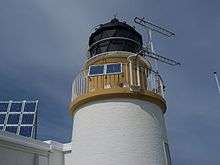Ailsa Craig Lighthouse
 Ailsa Craig Lighthouse | |
 Scotland | |
| Location |
Ailsa Craig Firth of Clyde Scotland |
|---|---|
| Coordinates | 55°15′07″N 5°06′30″W / 55.251898°N 5.108413°WCoordinates: 55°15′07″N 5°06′30″W / 55.251898°N 5.108413°W |
| Year first constructed | 1886 |
| Automated | 1990 |
| Construction | masonry tower |
| Tower shape | cylindrical tower with balcony and lantern attached to 1-storey keeper's house |
| Markings / pattern | white tower and lantern |
| Height | 11 metres (36 ft) |
| Focal height | 18 metres (59 ft) |
| Light source | solar power |
| Range | 17 nautical miles (31 km; 20 mi) |
| Characteristic | Fl W 4s. |
| Admiralty number | A4582 |
| NGA number | 4768 |
| ARLHS number | SCO-002 |
| Managing agent |
Northern Lighthouse Board[1] [2] |
The Ailsa Craig Lighthouse, is an active 19th century lighthouse located on Ailsa Craig, an island in the Firth of Clyde, just offshore from Girvan, South Ayrshire, Scotland.
History

It was completed in 1886, the construction being overseen by Thomas and David Stevenson.
Initially, the lighthouse used oil-burning lamps, but by 1911, these were replaced with incandescent lighting.
Fog signals were discontinued in 1987. Then, in 1990, the lighthouse was automated, and a refurbishment took place in 2001, when it was converted to run on solar power.
Ailsa Craig is also known as "Paddy's Mile Stone" as it lies halfway between the cities of Glasgow and Belfast. As well as being a local landmark and a well known marine navigational hazard the island is a protected bird sanctuary, sheltering thousands of breeding pairs of sea birds. Other wild life found on and around the island are a colony of grey seals as well as the occasional whale, and more commonly large basking sharks during the summer months. The basking shark is a large but harmless shark: it can often be seen from boats feeding at the surface on the planktonic bloom which grows in great abundance around the British Isles during the warmer months.
Geologically, the island was formed through volcanic activity and boasts large quantities of granite, which for a time was mined and shipped back to the main land where it was shaped and polished into curling stones. Mining began sometime in the early 19th century and ended in the early 1970s. Abandoned rails and bogies are all that remain. Landing on the island is by permit only, obtainable from the local authorities.
See also
References
- ↑ Ailsa Craig Lighthouse The Lighthouse Directory. University of North Carolina at Chapel Hill. Retrieved 8 May 2016
- ↑ Ailsa Craig Lighthouse Northern Lighthouse Board.Retrieved 8 May 2016
External links
| Wikimedia Commons has media related to Ailsa Craig Lighthouse. |